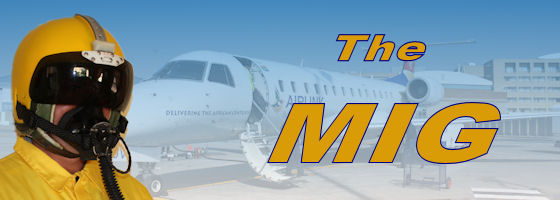

















The MIG As An Airline Transport Pilot

Ladies and gentlemen, welcome on board this flight SU-29 from Johannesburg to Moscow. I am your captain on this flight and I will be assisted by Anastasiya who will do most of the flying while I log the hours during my inflight sleep. The flight time will be as long as it takes to get there and we will fly somewhere above the clouds. This is my first time in the cockpit and I therefore request your attention during the safety demonstration. Remember, when you hear the brace command, put you head between your legs and kiss your arse goodbye.
YOU SHOULD HAVE FLOWN WITH AIRLINK!!!

While boarding an airliner, most people wonder who will be at the controls and if we are in safe hands. Is it The MIG flying or a real airline pilot? Well, with most airlines today the pilots are well trained with regular checks and simulator tests. This is especially true when it comes to South African based carrier “AirLink” and I was fortunate enough to spend a day on the flight deck of an Embraer 135 with Airlink's chief pilot Jaco Henning.

Passenger safety is not only in the hands of the cabin crew but also directly influenced by the airline's policies, procedures and support teams. I therefore joined Jaco early in the morning to get a feel for every aspect in the life of an airline pilot and to learn about everything behind the scenes keeping an airline running. My first introduction was the operation control centre. The OCC has a bird's eye view over the apron and can see most Airlink aircraft movements. It is also the OCC's responsibility to provide details such as passenger counts and load information to the pilots just before take-off. The airline's maintenance controller “Stefan Zaaiman” is also seated in this area so that pilots have direct contact with him for technical queries. The crew also have radio communication with Stefan for technical assistance during an in-flight emergency. Stefan has a library of the fleets technical manuals as well as maintenance records to ensure that information is immediately available if required.


At sign-on, every crew receives a briefing report which includes the flight details of the day, aircraft technical logs (or flight folios as we know it), NOTAMS, MET reports and fuel tanking requirements. The captain also receives a flight log which he checks, signs and keeps a copy to capture the actual values during the flight.

Arriving at the aircraft the captain performs a pre-flight inspection and provides preliminary fuel requirements to the ground crew. Only once the passenger count and baggage weight is known will the captain provide the final fuel requirements.

And then the fun - I mean paperwork starts. Flight logs, balance sheets, take-off analysis, passenger manifests… it doesn't seem to end! The pilot has been on duty for more than two hours now and still he has not logged a single hour.

With the first load of paperwork behind us, the luggage loaded and the passengers seated, it was time to close the doors, request start-up (and play with all the buttons of course). BUT, nothing gets done in this aircraft without completing a checklist by both the captain and the first officer.


We taxied out and after air traffic control issued the take-off clearance we were on our way. To me this was an amazing experience but I realised that you cannot fly the Embraer by the seat of your pants. The moment the wheels leave the ground the flight deck is extremely quiet, no vibrations or engine noise and you must be completely focused on the instruments.

Another checklist after take-off, undercarriage up and we were ready to make use of the aircraft's flight director to ease the workload. This system is programmed with all the flight details and includes all the possible procedures & plates for both the departure and destination airports. With a few commands, the flight director flies the correct procedures, climbs to the correct altitudes and makes all the inflight corrections when required. Next up, more checklists and paperwork.

The view from the flight deck is incredible and there is at least time for a cup of coffee before the checklists start again for the landing on the other side.



Our last leg of the day was a flight back to Johannesburg at sunset and considering the time we started, this has been a long day. Flying at night is even more spectacular and the view is indescribable.

You must be born to be an airline pilot and it is a tough life. You must be able to handle pressure, be prepared to work abnormal hours and your family must understand that you will be away from home on some weekends, Christmas and birthdays. However I am sure that it is a very fulfilling career.

I thoroughly enjoyed this exciting day in the flight deck and I thank Airlink for this unique and privileged experience.
 |
 |
 Copyright © 2024 Pilot's Post PTY Ltd
The information, views and opinions by the authors contributing to Pilot’s Post are not necessarily those of the editor or other writers at Pilot’s Post.
Copyright © 2024 Pilot's Post PTY Ltd
The information, views and opinions by the authors contributing to Pilot’s Post are not necessarily those of the editor or other writers at Pilot’s Post.